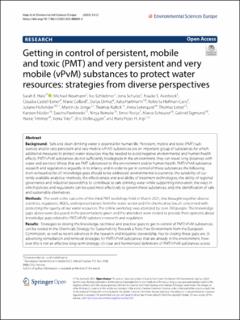| dc.contributor.author | Hale, Sarah | |
| dc.contributor.author | Neumann, Michael | |
| dc.contributor.author | Schliebner, Ivo | |
| dc.contributor.author | Schulze, Jona | |
| dc.contributor.author | Averbeck, Frauke S. | |
| dc.contributor.author | Castell-Exner, Claudia | |
| dc.contributor.author | Collard, Marie | |
| dc.contributor.author | Drmač, Dunja | |
| dc.contributor.author | Hartmann, Julia | |
| dc.contributor.author | Hofman-Caris, Roberta | |
| dc.contributor.author | Hollender, Juliane | |
| dc.contributor.author | de Jonge, Martin | |
| dc.contributor.author | Kullick, Thomas | |
| dc.contributor.author | Lennquist, Anna | |
| dc.contributor.author | Letzel, Thomas | |
| dc.contributor.author | Nödler, Karsten | |
| dc.contributor.author | Pawlowski, Sascha | |
| dc.contributor.author | Reineke, Ninja | |
| dc.contributor.author | Rorije, Emiel | |
| dc.contributor.author | Scheurer, Marco | |
| dc.contributor.author | Sigmund, Gabriel | |
| dc.contributor.author | Timmer, Harrie | |
| dc.contributor.author | Trier, Xenia | |
| dc.contributor.author | Verbruggen, Eric | |
| dc.contributor.author | Arp, Hans Peter | |
| dc.date.accessioned | 2023-01-16T10:09:38Z | |
| dc.date.available | 2023-01-16T10:09:38Z | |
| dc.date.created | 2022-04-03T19:36:48Z | |
| dc.date.issued | 2022 | |
| dc.identifier.citation | Environmental Sciences Europe. 2022, 34 (22), . | en_US |
| dc.identifier.issn | 2190-4715 | |
| dc.identifier.uri | https://hdl.handle.net/11250/3043639 | |
| dc.description.abstract | Background
Safe and clean drinking water is essential for human life. Persistent, mobile and toxic (PMT) substances and/or very persistent and very mobile (vPvM) substances are an important group of substances for which additional measures to protect water resources may be needed to avoid negative environmental and human health effects. PMT/vPvM substances do not sufficiently biodegrade in the environment, they can travel long distances with water and are toxic (those that are PMT substances) to the environment and/or human health. PMT/vPvM substance research and regulation is arguably in its infancy and in order to get in control of these substances the following (non-exhaustive list of) knowledge gaps should to be addressed: environmental occurrence; the suitability of currently available analytical methods; the effectiveness and availability of treatment technologies; the ability of regional governance and industrial stewardship to contribute to safe drinking water while supporting innovation; the ways in which policies and regulations can be used most effectively to govern these substances; and, the identification of safe and sustainable alternatives.
Methods
The work is the outcome of the third PMT workshop, held in March 2021, that brought together diverse scientists, regulators, NGOs, and representatives from the water sector and the chemical sector, all concerned with protecting the quality of our water resources. The online workshop was attended by over 700 people. The knowledge gaps above were discussed in the presentations given and the attendees were invited to provide their opinions about knowledge gaps related to PMT/vPvM substance research and regulation.
Results
Strategies to closing the knowledge, technical and practical gaps to get in control of PMT/vPvM substances can be rooted in the Chemicals Strategy for Sustainability Towards a Toxic Free Environment from the European Commission, as well as recent advances in the research and industrial stewardship. Key to closing these gaps are: (i) advancing remediation and removal strategies for PMT/vPvM substances that are already in the environment, however this is not an effective long-term strategy; (ii) clear and harmonized definitions of PMT/vPvM substances across diverse European and international legislations; (iii) ensuring wider availability of analytical methods and reference standards; (iv) addressing data gaps related to persistence, mobility and toxicity of chemical substances, particularly transformation products and those within complex substance mixtures; and (v) advancing monitoring and risk assessment tools for stewardship and regulatory compliance. The two most effective ways to get in control were identified to be source control through risk governance efforts, and enhancing market incentives for alternatives to PMT/vPvM substances by using safe and sustainable by design strategies. | en_US |
| dc.language.iso | eng | en_US |
| dc.publisher | Springer | en_US |
| dc.rights | Navngivelse 4.0 Internasjonal | * |
| dc.rights.uri | http://creativecommons.org/licenses/by/4.0/deed.no | * |
| dc.title | Getting in control of persistent, mobile and toxic (PMT) and very persistent and very mobile (vPvM) substances to protect water resources: strategies from diverse perspectives | en_US |
| dc.title.alternative | Getting in control of persistent, mobile and toxic (PMT) and very persistent and very mobile (vPvM) substances to protect water resources: strategies from diverse perspectives | en_US |
| dc.type | Peer reviewed | en_US |
| dc.type | Journal article | en_US |
| dc.description.version | publishedVersion | en_US |
| dc.source.pagenumber | 24 | en_US |
| dc.source.volume | 34 | en_US |
| dc.source.journal | Environmental Sciences Europe | en_US |
| dc.source.issue | 22 | en_US |
| dc.identifier.doi | 10.1186/s12302-022-00604-4 | |
| dc.identifier.cristin | 2014927 | |
| cristin.ispublished | true | |
| cristin.fulltext | original | |
| cristin.qualitycode | 1 | |

